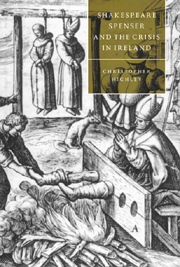Book contents
- Frontmatter
- Contents
- List of illustrations
- Acknowledgements
- Introduction: Elizabeth's other isle
- 1 Spenser's Irish courts
- 2 Reversing the conquest: deputies, rebels, and Shakespeare's 2 Henry VI
- 3 Ireland, Wales, and the representation of England's borderlands
- 4 The Tyrone rebellion and the gendering of colonial resistance in 1 Henry IV
- 5 “A softe kind of warre”: Spenser and the female reformation of Ireland
- 6 “If the Cause be not good”: Henry V and Essex's Irish campaign
- Notes
- List of works cited
- Index
- Cambridge Studies in Renaissance Literature and Culture
5 - “A softe kind of warre”: Spenser and the female reformation of Ireland
Published online by Cambridge University Press: 04 December 2009
- Frontmatter
- Contents
- List of illustrations
- Acknowledgements
- Introduction: Elizabeth's other isle
- 1 Spenser's Irish courts
- 2 Reversing the conquest: deputies, rebels, and Shakespeare's 2 Henry VI
- 3 Ireland, Wales, and the representation of England's borderlands
- 4 The Tyrone rebellion and the gendering of colonial resistance in 1 Henry IV
- 5 “A softe kind of warre”: Spenser and the female reformation of Ireland
- 6 “If the Cause be not good”: Henry V and Essex's Irish campaign
- Notes
- List of works cited
- Index
- Cambridge Studies in Renaissance Literature and Culture
Summary
On April 9, 1589, Lord Deputy Sir William Fitzwilliam informed Burghley about an unusual act of resistance among the Connaught rebels. Their leader, Sir Brian O'Rourke,
about two or three years since having found in a church or in some other place an image of a tall woman wrote upon the breast thereof QUEEN ELIZABETH, which done he presently fell with such spiteful and traitorous speeches to rail at it, and otherwise so filthily to use it … During which time his barbarous gallowglasses standing by played their parts as fast, who with their gallowglass axes striking the image one while on the head, another while on the face, and sometimes stabbing it in the body, never ceased until with hacking, and mangling they had utterly defaced it. And being nevertheless not contented herewith they … fastened a halter about the neck of the image, and tying it to a horse tail dragged it along upon the ground, and so beating it with their axes, and railing most despitefully at it they finished their traitorous pageant.
Images of the queen had been targets for her enemies in the past, but never had an act of lèse majesté in Ireland been so spectacular or proven so fascinating to English observers. Indeed, O'Rourke's desecration of the queen's statue entered the collective memory both in and out of Ireland as a touchstone of native barbarism. In 1605 Sir John Harington referred to the Irishman who “trayld Queen Elisabeth's picture at his horse tayle,” confident that his audience, Lord Mountjoy and Robert Cecil, would recognize the allusion.
- Type
- Chapter
- Information
- Shakespeare, Spenser, and the Crisis in Ireland , pp. 110 - 133Publisher: Cambridge University PressPrint publication year: 1997
- 13
- Cited by

